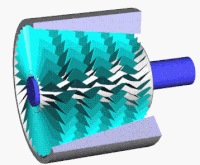
Photo from wikipedia
To get an insight into the occurrence and the mechanism of flow unsteadiness in the tip region of centrifugal compressor impellers, the flow in Krain’s impeller is investigated by using… Click to show full abstract
To get an insight into the occurrence and the mechanism of flow unsteadiness in the tip region of centrifugal compressor impellers, the flow in Krain’s impeller is investigated by using both steady and unsteady RANS solver techniques. It is found that the flow unsteadiness on the pressure side is much stronger than that on the suction side. The periodical frequency of the unsteady flow is around half of the blade passing frequency. The originating mechanism of the flow unsteadiness is illustrated with the time-dependent tip leakage flow and blade loading at the tip region. Due to the blockage caused by the joint effects of broken-downed tip leakage vortex, separated fluids and tip leakage flow at downstream, a low pressure region is formed on the pressure side, consequently the blade loadings is altered. In turn, the changed blade loadings will alter the intensity of tip leakage flow. Such alternative behavior finally results in the periodic process. By comparing the calculated flow field in the cases of single-passage and four-passage models, it is confirmed that the investigated flow unsteadiness is confined in each single passage, as no phase differences are found in the model of four passages. This is different from the situation in axial compressor when the rotating instability is encountered. The flow unsteadiness only occurs at the working conditions with small mass flow rates, and the oscillation intensity will be enhanced with the decrease of mass flow rate. When the mass flow rate is too small, the flow unsteadiness in a single passage may trigger rotating stall, as the disturbance propagates in the circumferential direction.
Journal Title: Science China Technological Sciences
Year Published: 2017
Link to full text (if available)
Share on Social Media: Sign Up to like & get
recommendations!